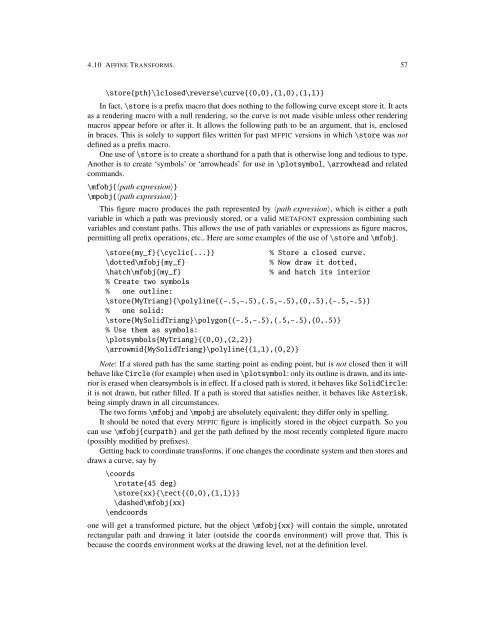Create successful ePaper yourself
Turn your PDF publications into a flip-book with our unique Google optimized e-Paper software.
4.10 AFFINE TRANSFORMS. 57<br />
\store{pth}\lclosed\reverse\curve{(0,0),(1,0),(1,1)}<br />
In fact, \store is a prefix macro that does nothing to the following curve except store it. It acts<br />
as a rendering macro with a null rendering, so the curve is not made visible unless other rendering<br />
macros appear before or after it. It allows the following path to be an argument, that is, enclosed<br />
in braces. This is solely to support files written for past MFPIC versions in which \store was not<br />
defined as a prefix macro.<br />
One use of \store is to create a shorthand for a path that is otherwise long and tedious to type.<br />
Another is to create ‘symbols’ or ‘arrowheads’ for use in \plotsymbol, \arrowhead and related<br />
commands.<br />
\mfobj{〈path expression〉}<br />
\mpobj{〈path expression〉}<br />
This figure macro produces the path represented by 〈path expression〉, which is either a path<br />
variable in which a path was previously stored, or a valid METAFONT expression combining such<br />
variables and constant paths. This allows the use of path variables or expressions as figure macros,<br />
permitting all prefix operations, etc.. Here are some examples of the use of \store and \mfobj.<br />
\store{my_f}{\cyclic{...}}<br />
% Store a closed curve.<br />
\dotted\mfobj{my_f}<br />
% Now draw it dotted,<br />
\hatch\mfobj{my_f}<br />
% and hatch its interior<br />
% Create two symbols<br />
% one outline:<br />
\store{MyTriang}{\polyline{(-.5,-.5),(.5,-.5),(0,.5),(-.5,-.5)}<br />
% one solid:<br />
\store{MySolidTriang}\polygon{(-.5,-.5),(.5,-.5),(0,.5)}<br />
% Use them as symbols:<br />
\plotsymbols{MyTriang}{(0,0),(2,2)}<br />
\arrowmid{MySolidTriang}\polyline{(1,1),(0,2)}<br />
Note: If a stored path has the same starting point as ending point, but is not closed then it will<br />
behave like Circle (for example) when used in \plotsymbol: only its outline is drawn, and its interior<br />
is erased when clearsymbols is in effect. If a closed path is stored, it behaves like SolidCircle:<br />
it is not drawn, but rather filled. If a path is stored that satisfies neither, it behaves like Asterisk,<br />
being simply drawn in all circumstances.<br />
The two forms \mfobj and \mpobj are absolutely equivalent; they differ only in spelling.<br />
It should be noted that every MFPIC figure is implicitly stored in the object curpath. So you<br />
can use \mfobj{curpath} and get the path defined by the most recently completed figure macro<br />
(possibly modified by prefixes).<br />
Getting back to coordinate transforms, if one changes the coordinate system and then stores and<br />
draws a curve, say by<br />
\coords<br />
\rotate{45 deg}<br />
\store{xx}{\rect{(0,0),(1,1)}}<br />
\dashed\mfobj{xx}<br />
\endcoords<br />
one will get a transformed picture, but the object \mfobj{xx} will contain the simple, unrotated<br />
rectangular path and drawing it later (outside the coords environment) will prove that. This is<br />
because the coords environment works at the drawing level, not at the definition level.

















